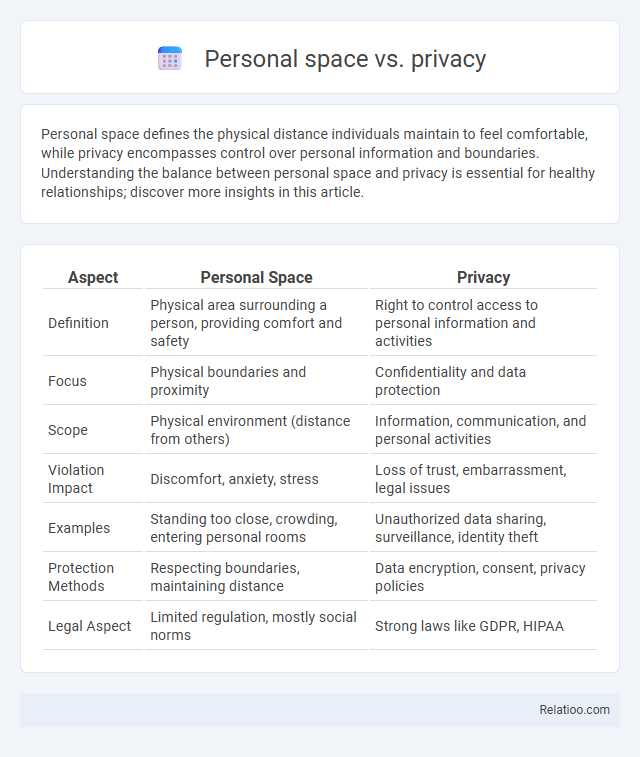Personal space defines the physical distance individuals maintain to feel comfortable, while privacy encompasses control over personal information and boundaries. Understanding the balance between personal space and privacy is essential for healthy relationships; discover more insights in this article.
Table of Comparison
| Aspect | Personal Space | Privacy |
|---|---|---|
| Definition | Physical area surrounding a person, providing comfort and safety | Right to control access to personal information and activities |
| Focus | Physical boundaries and proximity | Confidentiality and data protection |
| Scope | Physical environment (distance from others) | Information, communication, and personal activities |
| Violation Impact | Discomfort, anxiety, stress | Loss of trust, embarrassment, legal issues |
| Examples | Standing too close, crowding, entering personal rooms | Unauthorized data sharing, surveillance, identity theft |
| Protection Methods | Respecting boundaries, maintaining distance | Data encryption, consent, privacy policies |
| Legal Aspect | Limited regulation, mostly social norms | Strong laws like GDPR, HIPAA |
Understanding Personal Space
Understanding personal space involves recognizing the physical and emotional boundaries individuals maintain to feel comfortable and secure. Personal space varies by culture, context, and individual preferences, distinct from privacy, which focuses on protecting personal information, and distancing, often implemented for health or safety reasons. Respecting your own and others' personal space fosters positive social interactions and reduces stress.
Defining Privacy in Daily Life
Privacy in daily life refers to your ability to control access to your personal information, actions, and spaces, safeguarding intimacy and autonomy from unwanted intrusion. It encompasses protecting sensitive data, maintaining confidentiality in conversations, and ensuring your physical and digital boundaries are respected. Understanding these nuances helps balance personal space, privacy, and social distancing to foster comfort and security in everyday interactions.
Key Differences Between Personal Space and Privacy
Personal space refers to the physical distance individuals maintain to feel comfortable around others, typically ranging from 1.5 to 4 feet depending on cultural norms, while privacy involves control over access to personal information, thoughts, and activities. Your personal space is tangible and measured by proximity, whereas privacy is intangible and centers on confidentiality and autonomy. Distancing often relates to physical separation for health or safety reasons, distinct from the emotional boundaries defined by personal space and privacy.
The Psychological Impact of Personal Space
Personal space serves as a vital psychological buffer that affects your sense of safety and emotional well-being, distinguishing it from general privacy and physical distancing. Encroachments on personal space can trigger stress responses, heighten anxiety, and reduce comfort levels, influencing social interactions and mental health. Understanding the nuances between personal space, privacy, and distancing helps manage interpersonal boundaries and fosters healthier psychological functioning.
Why Privacy Matters in the Digital Age
Privacy matters in the digital age because your personal information is increasingly vulnerable to unauthorized access and misuse. Unlike personal space, which refers to physical boundaries, and distancing, which is a behavioral response, privacy encompasses control over your digital footprint and data. Protecting privacy ensures your online activities and sensitive information remain secure from hackers, corporations, and surveillance, preserving your autonomy in a connected world.
Cultural Perspectives on Personal Space and Privacy
Cultural perspectives heavily influence norms around personal space and privacy, with some societies valuing close physical proximity while others emphasize greater distance to maintain comfort. Your experience of personal space can vary drastically depending on cultural context, affecting social interactions and communication cues. Privacy expectations also differ globally, shaping how individuals protect their personal information and intimate boundaries within their communities.
How Technology Influences Personal Boundaries
Technology redefines personal boundaries by blurring the lines between personal space, privacy, and social distancing through constant connectivity and digital surveillance. Devices like smartphones and wearable technology facilitate real-time location tracking and data sharing, often encroaching on individuals' privacy and personal comfort zones. Advances in virtual reality and augmented reality create immersive environments that challenge traditional notions of physical distancing and space, requiring new etiquette and regulation to protect personal boundaries.
Managing Personal Space in Shared Environments
Managing personal space in shared environments requires clear boundaries to respect individual comfort and privacy, minimizing stress and conflict. Effective strategies include spatial design that balances proximity with privacy, use of physical markers like partitions, and promoting social norms that recognize personal boundaries. Maintaining appropriate physical distance enhances well-being, fosters collaboration, and reduces the risk of privacy violations in offices, communal areas, and public settings.
Legal Aspects: Rights to Privacy vs. Personal Space
Legal aspects of privacy protect individuals' rights to control access to personal information and private communications, reinforced by laws like GDPR and the Fourth Amendment. Personal space, while socially respected, lacks specific legal statutes but overlaps with privacy when unauthorized physical intrusion occurs, which may lead to claims of trespassing or harassment. Distancing measures, often implemented through public health mandates, intersect with privacy rights by regulating physical proximity without infringing on personal data or private life.
Tips for Respecting Both Personal Space and Privacy
Respect your personal space by maintaining an appropriate physical distance, typically around 18 inches to 4 feet, depending on the social context. Protect privacy by refraining from unsolicited questions or intrusions into personal matters, and ensure digital boundaries by securing sensitive information. You can create a comfortable environment by observing these tips and acknowledging individual preferences for space and confidentiality.

Infographic: Personal space vs Privacy
 relatioo.com
relatioo.com